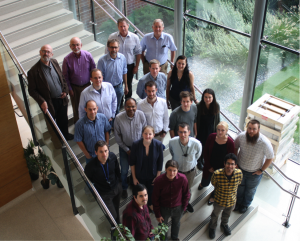With LCWS in Morioka just over eight weeks away, and several new students from the University of Oregon, University of California at Santa Cruz and University of Texas at Arlington joining the optimisation effort, the SiD optimisation group decided that the time was right to hold a workshop dedicated to getting new users up to speed with how to use a different framework. The Pacific Northwest National Laboratory (PNNL) hosted the event, and 20 people from the U.S. and Europe found their way to Richland, WA, about 14 miles away from the LIGO Hanford Observatory.
While the ILC accelerator published their TDR in 2012, the detectors still have a way to go before they can publish their TDRs. The SiD detector consortium decided at the end of 2015 to change their simulation and reconstruction to the new framework developed by ILD and CLIC, which is partially supported by the EU-AIDA2020 project. This change is quite disruptive, as users are moving from tools written in Java to a purely C++-based infrastructure. However, it became mandatory due to the lack of support for SiD’s core software framework.
The benefits of having a common event data model like LCIO became obvious, as simulations and reconstruction files produced in the old framework could easily be read in the new framework.
The first day of the meeting consisted of software tutorials, primarily prepared by the Glasgow group. While there where the usual unexpected software teething problems, we were able to soldier on and simulated single particles with a version of the SiD detector using the new DD4HEP geometry description. We hope to get much closer to a production version by LCWS 2016 meeting.
The second day was dedicated to detector studies, beginning with a warm welcome to PNNL by the Signature Science and Technology Division Director Randy Hansen, and a historical perspective from Marty Breidenbach, spokesperson of the SLD collaboration at the last high-energy linear accelerator. The day was capped with a lovely dinner at a local winery. The third day was devoted to physics studies, ranging from a study of double Higgs production in the context of an effective field theory to SUSY searches in the forward detectors.
The times are certainly challenging, but SiD keeps taking steps towards a TDR and realising the detector concept. If the spirit at the workshop is any indication, we have a lot of interesting studies ahead of us. I personally look forward to new SiD material at the LCWS in Morioka.


Recent Comments